Interview: Sean Parnell, Chicago Bar Project
By Karl Klockars in Arts & Entertainment on Jun 16, 2008 5:00PM
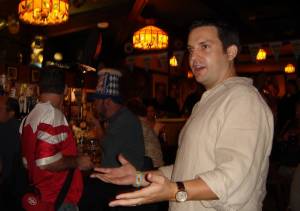
If you've ever looked for info on the bar you're going to on any given Friday night, you've most likely run into Sean Parnell's site, the Chicago Bar Project. Started in 2000 and now listing hundreds of bars (including dozens that are no longer in existence), the Bar Project has changed from a simple list of nightspots into a comprehensive guide to almost all alcoholic destinations throughout the city.
The Bar Project's entries range from short in-memoriam blurbs to comprehensive historical recaps of decades of bar history. But how does Parnell get all that information? Where does he prefer to enjoy a beer or nine? What's the story behind his other site, the Abandoned Lot Project? And just how much does he drink? On that last question, perhaps the world will never know - but there's more on all the rest, after the jump.
Chicagoist: Do you ever look back over the past 8 years and wonder, “How did I do all these reviews?”
Sean Parnell: There are at least a couple hundred places that I’ve been to that I haven’t had time yet to write about. The biggest risk there is that what I write about is out of date, which even when I write about a place I like to keep updating it over time. The photos, or something’s changed, especially remodeling – of course if they close I migrate it over to the Memoriam section of the site.
My biggest challenge is having the time to write. Because it’s very much a hobby at the moment. I’ve gone through periods where I haven’t written anything for months. And then I’ve gone through periods where I’m highly productive. Overall, each year, I try to add a lot of new places, update a lot more, and also a lot of people contact me as well. I sometimes post their stories, their comments – each page has become a kind of a living history of the place.
C: Sometimes I check out places like Metromix or Centerstage and feel bad for the person that is constrained to the tiny 300 word blurb, compared to your extremely long, well researched pieces. How do you go about getting all your info?
SP: First of all, I won’t write about a place unless I actually go to it. Which actually, some who will go without being mentioned have been guilty of. Because there’s a lot of recycling on the web; you can kinda tell. Especially when you see something that’s been outdated for years – for example I’m pulling together a page on the Bucktown Pub. I’d been there once a long time ago, felt like I couldn’t even remember what it was like, and I went back.

And I found out was that it had been completely renovated. And what it was well known for was the crazy posters on the wall, every inch of space taken up by something, the pinball machine – what had happened was, that had all been taken out, I think a couple years ago. And you’ll still see reviews on it talking about how it used to be. When I think the ownership turned over in 2001.
Anyways, I like to go to places at least twice, if not three times – many of the places I’ve been to many, many times. Because I’ve lived in Chicago now since ’96, and I tend to go out a lot. Especially in the first 7 or 8 years I’ve been here, I was probably going out 3 or 4 times in a week. #1 most important thing is to go to the place, get a feel for it first hand, sometimes have a change to talk to the patrons, bartenders. Try to be anonymous. I’m not in it to get free drinks out of bartenders or bar owners or anything like that.
But I also have – I’m looking at ‘em right now – about 50 different guides to Chicago. Going back to the 60’s, that cover bars, restaurants, some are ethnically oriented, some are about blues bars, romantic places, cheap places to go... so I’ve got all the guides I can possibly find. Including the main bar guides that have been written.
So I go to a place, check it out maybe a couple times, maybe more. I’ll write my own notes about a place – that’s my primary research. Secondary research, I’ve got those 50 guide books that I’ll go through trying to find as much information as I can. In addition to that, I’ll do extensive web searching. I’m more interested in seeing what personal reviewers have to say, especially like on Yelp is a great example. It’s all user generated, and there’s a lot of great information there. Y’know, I’m not 21. So I’m not sure if a place is going to appeal to 21 year olds. I’m 34, so I know if it’ll appeal to my kind of person.
But it’s good to get a sense of what others are saying about it, too, just to get a better feel for a place beyond my opinions and perspectives. But sometimes, I’ll run across a good review and I might actually post that review in my writing. And then I also take pictures, I find pictures on the web, get permission to post those. I try to make it more visual, I like to make it colorful, try to get as many photos as I can, sometimes from the bar site – always put a link to the bar.
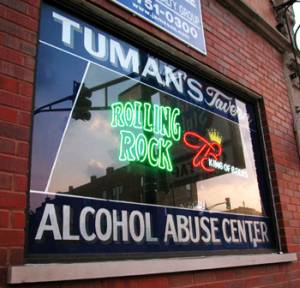
And I’ve got kind of a formula for writing the reviews. Always like to talk about beer selection, booze selection if it’s notable, food selection if it’s notable. Do they serve food, how good is it? What other cool things about it? The history of the place – what was it before, when did it open, who owns it, do they own anything else. And sometimes I’ll go off on rants or tangents, because I can. I have no editor other than myself and my conscience so that’s usually how it gets pulled together.
And I encourage people to contact me, like you did and like a lot of other readers do. I like it when people send me stories and comments – a lot of people send stories about bars that are no longer around, because I think they get nostalgic for days when they were young, and going out. So they see if the place is still open or if there’s anything on the web, and if I’ve written about it, I get a lot of feedback from that.
C: There’s barely any advertising on the site, so you’re not getting rich from the Bar Project - what do you get out of doing this?
SP: You know, I’ve always been interested in writing, but I never knew what to write about. I’d dabbled in starting to write some fiction but it came out….poorly would be an understatement. So they always say write what you know – the Bar Project started when I got kinda frustrated with what I was seeing out there. And I felt like, “Why doesn’t someone who goes to these places, a local, write about these places?”
My brother had given me a domain for my birthday present back in ’99, and I didn’t know what to do with it. Shortly thereafter, that frustration came out - I was thinking, “You know, maybe I should write about some of these places that I really know.” Because, at the time, there was Metromix, and a couple others – nowhere near the amount of information that’s out there now.
But I kinda felt like I should write about these places. Because I knew so many crazy people, and so many hilarious stories, but it’s like, “I’ll write about this place from a local’s perspective, add these funny stories, it’ll be really fun – and it’ll help me remember what I get up to.” Because I would go to work on Monday morning and people would ask me “What’d you do during the weekend,” and I’d draw a blank. Not because I was blind drunk (although sometimes that was the case), but because I did so much, I’d just forget.
Overall, it’s a creative outlet for me. It’s a way to remember these places and what I’d done on my own, and it’s led to some interesting projects.
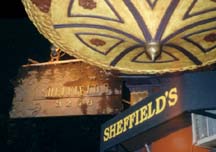 C: In the big long compilation of lists you’ve amassed, the two I’m not seeing here is: Your favorite bar and the bar you miss the most.
C: In the big long compilation of lists you’ve amassed, the two I’m not seeing here is: Your favorite bar and the bar you miss the most.
SP: There are a few different answers for that. It really depends on my mood, time of year, phase of the moon, who I’m going out with – but I did put on the page the “Best Bars of 2007.” I have to say, I was very impressed with Sheffields, after their recent expansion/renovation, and now addition of barbecue to the menu, I think that is currently the best, well rounded pub in the city. So I would say that’s my current favorite, although to be honest, I’ve only been there once in the past year.
Then it goes down by bar type. If I’m in the mood for an Irish pub with the best Shepherd’s Pie, I’ve got a place in mind, and if somebody’s in from out of town I usually always take them to the Hopleaf or the Green Mill. Maybe some other places depending on their mood – Duke of Perth I recommend a lot because their scotch selection is top notch, as well as their traditional Scottish food, although I am disappointed that they’ve gotten rid of the steak and kidney pie. That was quite a blow to my diet, although probably for the best. Those are places that usually come up.
I love places that have a lot of different kinds of beer – Quenchers and their…they do a European Beer Festival every year. Map Room is very cool. There’s the Hop Haus – although it’s got a kind of a cheesy name, they’ve got a very intriguing selection of beers as well as game on the menu. And I like a place with a story. Places that have interesting history, that have more than one thing about it – maybe it’s music, maybe it’s food, maybe it’s beer selection, maybe an interesting tradition that started there, those things are all related.
And the as far as the memorial section, my personal favorite is probably the Chicago Playboy Club. Just because, that was such a unique place. Hugh Hefner being from here, and whether you’re into the Playboy Empire or not, I think it was a fascinating part of our nightlife history, come and gone. I get a lot of email about the Gold Star Sardine Bar, that still sits vacant – I was in the building today, it’s still vacant.
 My biggest heartache comes from the deathspiral and closing of JT Collins. That was a bar that was about a hundred yards from my apartment for about 5 years. And I had been to it even before that. They had really cool bartenders, old-school bartenders – not old bartenders, but you’d be sitting there and they’d be buying you a beer, you’d buy them a shot, they’d sponsor your softball team.
My biggest heartache comes from the deathspiral and closing of JT Collins. That was a bar that was about a hundred yards from my apartment for about 5 years. And I had been to it even before that. They had really cool bartenders, old-school bartenders – not old bartenders, but you’d be sitting there and they’d be buying you a beer, you’d buy them a shot, they’d sponsor your softball team.
They had a good, though not extensive, beer selection, though they had a cask conditioned ale on tap. They had a menu of food that they actually had an award winning chef design – who puts that kind of effort into a corner neighborhood pub? It appealed to young and old alike, and it was always where we’d start off the evening, or have a nightcap if they were still open. So that’s what I had the most heartache over.
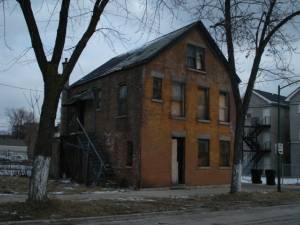
C: I want to switch gears and ask you about the Abandoned Lot Project. What made you want to take on something that’s so 180 degrees from the bar project? What’s the motivation behind it?
SF: Well, I took something called the Landmark Forum, that’s actually the first of a trilogy of seminars designed to get the most out of life. More than self-help, more like self-empowerment. And even if you are successful, [it’s] how to be more successful. They’ve got some various methodologies around it, which many who haven’t taken it look at as a cult. There’s some negative things to say, but for me it’s been a really powerful experience.
I think that each of the three seminars are different crossroad points of my life. At each time, I’d been looking for something and I felt like I might be on the wrong track. The third of the Landmark series of seminars is the self-expression and leadership program. I had some challenges in my job at the time and some difficulties with people and I kinda felt unhappy with what I was doing. I felt I needed something to get me back on track. Get my mind out of where it was, and think about some new possibilities.
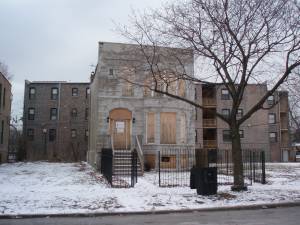
[In] the self expression and leadership program you embark on a project of your own choosing, your own design. They have a couple criteria about it – your project goes for three months and there needs to be some measureable result, to hold yourself accountable for the things you’ve done. And in the leadership component is getting others involved. And also at certain times in the project stepping away and letting others step up, to see if they can do more than just something by yourself. Because if you’re really going to have an impact in your community and beyond, those are the sort of things you should do. Is have others involved, and sometimes lead and sometimes follow.
So I started the Abandoned Lot project out of my frustration and shame that great parts of a great city are living in third-world conditions. I love Chicago and I have yet to find a place I’d rather live. But when you take a drive down to the south side and the west side, Austin, Lawndale, East and West Garfield Park, go down south to Englewood, Back of the Yards, Gresham – they look like there’s been a war. There’s bombed-out homes, a lot of them have been torn down, thanks to the city’s Fast Track demolition program, which has its pros and cons.
But I’ve been very frustrated and ashamed about how since the riots in the sixties, huge swaths of the south and west side have lain in waste. Abandoned buildings mostly on the west side, some vacant lots, which is kind of the reverse of the south side, where you do have a number of abandoned buildings but you have an incredible number of vacant lots. And if you think about the economic conditions down there, there are very few grocery stores, very few restaurants, a handful of bars and these are not the fun places on the north side – these are all nasty, hole-in-the-wall bad places, except for a handful of blues bars that offer something more than just alcoholism.
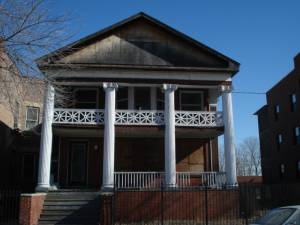
Anyways, I wanted to do something that had a positive impact at the community level – never done a community project, and I thought, “well, what am I good at?” I just explained what I was interested in, but how could I apply that? Well, I created the Chicago Bar Project and that’s given a lot of exposure to bars in a very positive way. What if [I] take it in the opposite direction and expose some of the things that are really bad about the city? That these abandoned buildings would be allowed to lay vacant for sometimes 20, 30, 40 years? Because abandoned buildings are magnets for drug activity, and fires, and all kinds of illegal activity – and they’re just dangerous. Staircases can collapse, floors can collapse, there’s rats in there. They’re magnets for bad things.
And think about, what if you owned a property next to an abandoned building that sits vacant for 20 years? What’s that going to do to your property value? That can affect the property value of the whole neighborhood if it’s an especially bad one. So I was hoping to enact some positive change, and try to get some of these places dealt with. I had to pick five to fit within the scope, but I thought “what am I going to be able to do in three months, that will have an impact?”
C: So did it have the impact you were looking for?
SP: The results were mixed. I created the website, which has probably been the most positive thing, because it’s something visible for things you might normally not see. It really wasn’t a direct link to the Bar Project other than it’s me doing it. And I linked just my personal SeanParnell.com – that’s actually where the Chicago Bar Project originally lived.
So I chose five [lots], and each of the five had varying degrees of success – one was actually torn down, but I don’t know if it had anything to do with my efforts. But it was a particularly nasty one in Lawndale. Another one, the alderman said “there’s nothing I can do about it”- later, Fox News did a special on abandoned buildings and vacant lots and included me in that – we went to some places and interviewed some people I had worked with in the 4th ward, actually doing a lot of great things down there. If anyone’s doing some positive about it, it’s in the 4th ward with Alderman Preckwinkle and her staff. They’re doing some cool things. Those abandoned buildings remain a problem even in their district where it’s had the most positive change in the entire south side.
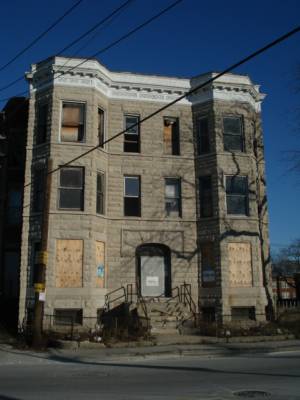
What I realized at the end of this was – and I’ve kinda stepped away from it, I haven’t kept the Abandoned Lot project going, I still have the photos that I took up there, I still have information on sites that were abandoned at the time of the writing. Not sure if they’re still abandoned – I think probably about 95% of them are. But interestingly, people will contact me from time to time, mostly students. Sometimes people who are interested in the subject, some people who have abandoned lots in their neighborhood, and they can’t stand them and they’re affecting their property prices and what do they do?
And honestly, I’ve struggled to really answer [them]. Because as a result of this project, as I said before it had mixed results – I’m not sure exactly what kind of impact it had. I kind of toy with the idea of continuing with it and taking a photo of every abandoned lot and building in the city, and keeping it going. The thing that drives me crazy, is that we have essentially accepted this situation. There’s only a handful of people, like Alderman Preckwinkle in the 4th ward that are doing something really positive and seeing a lot of economic development in their area.
Others just are chronically depressed, and the people in the neighborhood are resigned to the shootings, to the drugs and the abandoned buildings. Certainly Mayor Daley seems quite resigned to it. He seems greatly uninterested in doing anything about this – at least as far as I can see. And people here in the pleasant North Side and other areas of the city that are decent, we just avoid those areas. And we tell people not to go there.
But is that acceptable? People who live in third-world conditions, so close in proximity to us, they’re really our fellow neighbors, even though they’re just a little further away. It’s just one city, isn’t it? It’s just one world. For us to be indifferent and complacent to it, I think is really shocking. That in and of itself, is what holds Chicago back from being a world-class city. Of being worthy of the Olympics. Of being a great place to live for anybody in any income bracket.
You’re always going to have some problems with poverty, and you try and minimize those as much as you can, and it’s up to the individual for the large part, but it is up to the community – not just the neighborhood, but I think the city as a whole to do something about it.